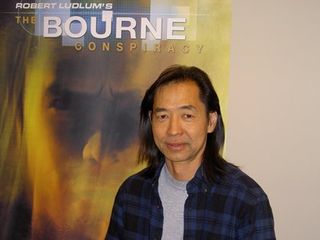Who's the hardest man in Hollywood?
We quiz stunt guy extraordinaire Jeff Imada on his work on The Bourne Conspiracy, and find out who's the best fighter in movies
Admittedly, we didn't have the faintest idea who Jeff Imada was when he was wheeled out as the guest star at a recent press event for The Bourne Conspiracy game. But following some hasty internet researchit became apparent that while his name isn't that well known he's worked as a fight co-ordinator and stunt director on some of the biggest films of the last 30 years.
Try this little list for starters: Fight Club, Planet Terror, 8 Mile, LA Confidential, Heat, Falling Down, Bill and Ted's Excellent Adventure, Lethal Weapon, Rambo and Bladerunner. Getting him to work on the fight sequences in The Bourne Conspiracy was a pretty sharp move.
And while we could have spent many hours talking about his time working with best mate John Carpenter and the late Brandon Lee, we felt obliged to allocate 85% of the time to discuss Bourne. Which is fine - the fight sequences are undoubtedly one of the highpoints of the game and films.

Above: That's Jeff. You don't want to f*** with him. He's got moves.
GamesRadar: Is Bourne the first videogame you have worked on?
Jeff Imada: No, another game I was heavily involved with was GoldenEye, but Bourne is the first one I really came in on the conceptual meetings. It's been a really great experience.
GR: How did you find the transition from films to videogames?
Sign up to the 12DOVE Newsletter
Weekly digests, tales from the communities you love, and more
JI: There's a lot of overlap. I'd done some motion-capture before and videogame stuff when they wanted to incorporate it into films. The main differences are that in film you shoot everything and what you see is what you get and things are shot in one long sequence.
In videogames you're shooting small vignettes of movements and combinations of movements. Then it's incorporated and built upon. It's more intensive than a film - in a movie when you see 20 moves we've only filmed 20 moves, in a game the player may only use 20 moves in a sequence but we've had to capture 100 to give the player the impression of variety.
Also when you're working on a set, you film and then you stop to tweak a light or move a camera to a different angle so the actors get a chance to take a break. But when you do mocap, you're on your feet 8-10 hours a day.
GR: There's obviously more of a delay in seeing what your sequences look like after mocap, compared to a film where you can watch playback almost instantly - does this cause you any problems when choreographing a fight?
JI: There's good and bad sides to it I think. As much input as I have, it's the player that dictates the combination of the moves, so you're not always sure how they're going to turn out. So we have to be very careful during mocap to make sure that when moves are combined by the player they look good and there's a smooth transition from single moves to a combination of moves
.

GR: Did working with the Bourne game give you a freedom to implement things you couldn't do in the films?
JI: Yes - with regards to the shooting, you're basically creating the reality of your world so you can change the environment and backgrounds after you've done your mocap.
Also, when you see a game character get his head slammed into a table or into a wall we can capture that by slamming his head into a foam block rather than into a real table. So it's easier safety wise and things don't have to be built in such a precise way to be seen on screen.
In a videogame you might play the game two or three times and the fights will turn out differently. When you can move the camera around cinematically, you get a different perspective of the action that maybe wouldn't be possible in film.
GR: In the Bourne films you use three objects as weapons - the pen, the book and the magazine. When you were thinking about new objects for the game how did you come up with new ideas for makeshift weaponry?
JI: I got feedback on where the fights would be taking place - inside, outside, in an office - having that knowledge influences me on what everyday items we can use as a weapon. So if I'm walking around in here [gestures to interview room] I'd be thinking I can use a bottle, a fire extinguisher, a chair, a microwave.
When it comes to picking things up it's pretty endless in a game environment - I can use a bottle for example and we don't have to use 10 or 20 Breakaway bottles at $100 a pop. We just capture the motion and insert the bottle in later. It gives me a lot more flexibility as I can chose anything and the programmers can make it work.













After 37 years, this Commodore 64 classic returns with a new Metroidvania sequel that gives serious old-school Castlevania vibes

Fortnite has had Tomb Raider's Lara Croft locked away in battle pass exclusivity jail for almost 4 years, but she's reportedly getting a new skin very soon





